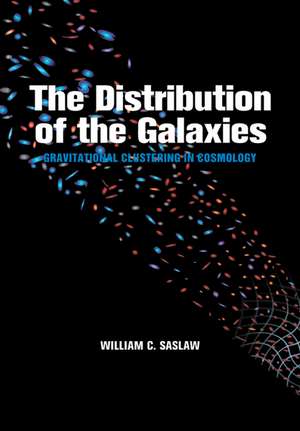The Distribution of the Galaxies: Gravitational Clustering in Cosmology
Autor William C. Saslawen Limba Engleză Paperback – 3 feb 2008
| Toate formatele și edițiile | Preț | Express |
|---|---|---|
| Paperback (1) | 479.27 lei 6-8 săpt. | |
| Cambridge University Press – 3 feb 2008 | 479.27 lei 6-8 săpt. | |
| Hardback (1) | 867.84 lei 6-8 săpt. | |
| Cambridge University Press – 27 oct 1999 | 867.84 lei 6-8 săpt. |
Preț: 479.27 lei
Nou
Puncte Express: 719
Preț estimativ în valută:
91.71€ • 96.01$ • 75.88£
91.71€ • 96.01$ • 75.88£
Carte tipărită la comandă
Livrare economică 07-21 aprilie
Preluare comenzi: 021 569.72.76
Specificații
ISBN-13: 9780521050920
ISBN-10: 0521050928
Pagini: 524
Ilustrații: 114 b/w illus. 1 table
Dimensiuni: 170 x 242 x 28 mm
Greutate: 0.83 kg
Editura: Cambridge University Press
Colecția Cambridge University Press
Locul publicării:New York, United States
ISBN-10: 0521050928
Pagini: 524
Ilustrații: 114 b/w illus. 1 table
Dimensiuni: 170 x 242 x 28 mm
Greutate: 0.83 kg
Editura: Cambridge University Press
Colecția Cambridge University Press
Locul publicării:New York, United States
Cuprins
Prologue; Part I. Historical: 1. Cosmology myths and primitive notions; 2. First qualitative physics: the Newton-Bentley exchange; 3. Glimpses of structure; 4. Number counts and distributions; 5. Seeds of grand creation; 6. Clusters versus correlations; 7. The expanding search for homogeneity; Part II. Descriptions of Clustering: 8. Patterns and illusions; 9. Percolation; 10. Minimal spanning trees; 11. Topology; 12. Fractals; 13. Bound clusters; 14. Correlation functions; 15. Distribution functions; Part III. Gravity and Correlation Functions: 16. The growth of correlations: I. A fluid description; 17. The growth of correlations: II. A particle description; 18. General correlation properties; 19. Computer simulations; 20. Simulations and observations of two-particle correlations; Part IV. Gravity and Distribution Functions: 21. General properties of distribution functions; 22. Dynamics of distribution functions; 23. Short review of basic thermodynamics; 24. Thermodynamics and gravity; 25. Thermodynamic formulation of the cosmological many-body problem; 26. The functional form of b(n,T); 27. Derivation of the spatial distribution function; 28. Properties of the spatial gravitational quasi-equilibrium distribution; 29. The velocity distribution function; 30. Evolution of the GQED; Part V. Computer Experiments for Distribution Functions: 31. Spatial distribution functions; 32. Velocity distribution functions; Part VI. Observations of Distribution Functions: 33. Observed spatial distribution functions; 34. Observed peculiar velocity distribution functions; 35. Observed evolution of distribution functions; Part VII. Future Unfoldings: 36. Galaxy merging; 37. Dark matter again; 38. Initial states; 39. Ultimate fates; 40. Epilogue; Bibliography; Index.
Recenzii
'The students should listen to this author and closely study his work.' Irish Astronomical Journal
'… the approach does a great deal to make difficult ideas accessible … I enjoyed reading this book and hope that it will bring Saslaw's ideas to a wider audience and establish their true significance.' David Matravers, General Relativity and Gravitation
'From the title of the book one could get the impression that it represents nothing but one of those many in the astrophysical literature describing the observations of galaxies and the methods to get these results. However, the present book is also mathematically well-founded, and even if one is not at all interested in any results on the distribution of galaxies, this book is worth being consulted.' H.-J. Schmidt, Zentralblatt für Mathematik
'… can be highly recommended to researchers at graduate student level and above as a near-definitive treatise on the application of distribution functions to cosmology.' J. Loveday, Contemporary Physics
'… the approach does a great deal to make difficult ideas accessible … I enjoyed reading this book and hope that it will bring Saslaw's ideas to a wider audience and establish their true significance.' David Matravers, General Relativity and Gravitation
'From the title of the book one could get the impression that it represents nothing but one of those many in the astrophysical literature describing the observations of galaxies and the methods to get these results. However, the present book is also mathematically well-founded, and even if one is not at all interested in any results on the distribution of galaxies, this book is worth being consulted.' H.-J. Schmidt, Zentralblatt für Mathematik
'… can be highly recommended to researchers at graduate student level and above as a near-definitive treatise on the application of distribution functions to cosmology.' J. Loveday, Contemporary Physics
Descriere
This volume, first published in 2000, examines one of the leading problems in astronomy today - how galaxies cluster in our Universe.









